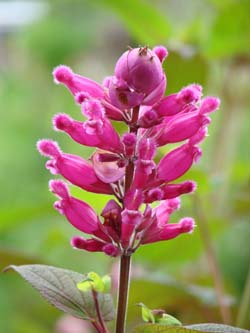(Nuevo Leon Downy Sage) From the high mountains of Nuevo Leon, Mexico. This unusual variety has very large flowers in loose clusters. Early to bloom and more cold tolerant than other Downy Sage varieties, it is ideal for gardens on the edge of it's climatic adaptability.
The "puberula" part of the species' scientific name refers to the velvety hairs of its light green leaves.
This is a large, open branched shrub reaching up to 6 feet tall and 4 feet wide. Its deep magenta flowers are also big, growing almost 4 inches long in clusters atop tall spikes that look pretty in floral displays.
If you live in an area with mild winter temperatures, you can expect intense color from late summer into winter. Where we live on the Northern California coast, our established plants continue to bloom most years until early spring, even following snow, hail and multiple days of cold rain. Also, we've found that a hard pinch back during late spring makes for a more compact plant at bloom time.
Nuevo Leon Downy Sage grows well in full sun to partial shade and in USDA Zones 7 to 11. It likes well-drained soil that is neither poor nor rich and requires average watering based on local conditions. Grow it as a screen, background planting or part of a shrub border.




